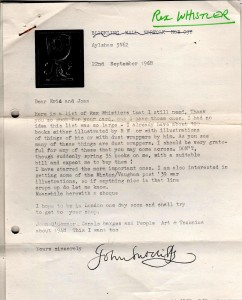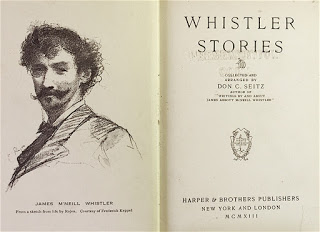 That’s the English Rex rather than the American James McNeill. This covering letter, which was rescued from the archives of the booksellers Eric and Joan Stephens, was sent on 22 September 1968 from the National Trust property Blickling Hall, Norfolk, by the artist and Rex Whistler fan, John Sutcliffe. This letter bears a characteristic scraper board design by Whistler as a sort of letterhead. That’s how much Whistler meant to Sutcliffe.
That’s the English Rex rather than the American James McNeill. This covering letter, which was rescued from the archives of the booksellers Eric and Joan Stephens, was sent on 22 September 1968 from the National Trust property Blickling Hall, Norfolk, by the artist and Rex Whistler fan, John Sutcliffe. This letter bears a characteristic scraper board design by Whistler as a sort of letterhead. That’s how much Whistler meant to Sutcliffe.
The letter explains that despite owning ‘about 100 books either illustrated by R.W. or with illustrations of things of his or with dust wrappers by him’, Sutcliffe still needs a number of items to complete his collection. He also wants some post-war illustrations by John Minton and Keith Vaughan. The most coveted items on the wants list are marked with asterisks and include Mildred(1926), Lady Cynthia Asquith’s Treasure Ship(1926) and Edith Olivier’s As Far as Jane’s Grandmother’s(1928). Later priorities are the rare Edward James booklet Your Name is Lamia, which was printed by the author in 1933 in an edition of just thirty copies, and two books by Edith Olivier and Dorothy Wellesley, for which Whistler designed the dust jackets. Sutcliffe also asks Eric and Joan to look out for certain issues of periodicals—mainly from the thirties– devoted to design and decoration. These periodicals include The Architectural Review, The Artist, The Studio, The Connoisseur and Decoration. It is not explained whether or not Whistler contributed to these publications.
Little is known about John Sutcliffe, apart from the fact that he seems to have been a graphic designer who revised James Lees Milne’s original NT guide to Blickling Hall and wrote a ten-page pamphlet on the Hall’s Library in 1971. It may be that he worked at the Hall while writing these two works. He doesn’t appear to have lived there at any time. As an artist he co-exhibited at the 1967 Lynn Festival and there is at least one work by him among the art collection at the Hall. If he is the John Haddon Frowde Holman Sutcliffe who is listed as working for Read & Sutcliffe of King’s Lynn as an artist, then his name suggests that his parents were artists too, or at least art lovers. As we know, David Haddon and Holman Hunt were nineteenth century artists of some eminence.
But all this is less interesting to us at Jot HQ than the fact that John Sutcliffe was a fanatical collector of work by arguably the most gifted illustrator of the twentieth century. [RR]



